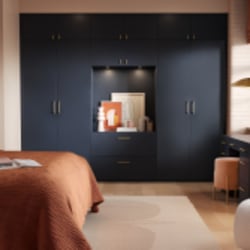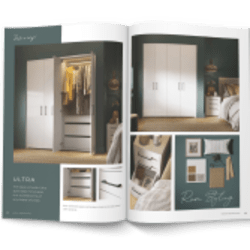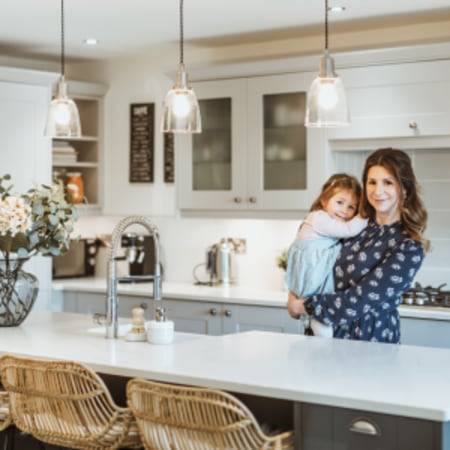Tumble Dryers: Buying Guide
Tumble Dryers
Kitchen appliance technology has come a long way in the last decade, making life less time consuming and chores more convenient. Washing machines mean we no longer have to wash clothes by hand, and microwaves can cook us food in mere minutes. But if there’s one appliance that embodies handy convenience, it’s the tumble dryer.
No other kitchen appliance is quite as time-saving as a tumble dryer. Yes, a dishwasher means you don’t have to tackle big dirty pans, but a tumble dryer means you can have wet clothes dry in mere minutes. With a tumble dryer in your home, you don’t have to hang your clothes outside for hours on end to dry, which also means no rushing out to save them when it starts to rain, or risking losing shirts on a blustery day.
Of course, there are plenty of different types of tumble dryers available on the market, which might leave you asking, ‘which tumble dryer should I buy?’ You could go out and pick up the first tumble dryer that takes your fancy, one with all the modern bells and whistles, but buying a tumble dryer is more nuanced than that. You need to consider things like how much space you have, what your budget is, and whether you can actually accommodate the type of tumble dryer you’re interested in.
That’s why we’ve created this detailed tumble dryer buying guide to help you decide which tumble dryer to buy. We’ll walk you through all the information you’ll need to know, leaving you capable of making an informed purchasing decision.
Before you start
In order to work out what type of tumble dryer is best for your home, you first need to consider three key factors. Space, budget, and energy efficiency. Much like a washing machine or fridge, you want to buy a tumble dryer that will fit the space you have while saving you as much money as possible in the long term.
Once you’ve developed a firm understanding of these three factors, the buying process will become immeasurably easier.
Space
Space is the most important factor you’ll need to consider when you buy a tumble dryer. Luckily, unlike ovens and washing machines, tumble dryers come in a very limited range of measurements. In fact, the size of your tumble dryer will usually be dictated by whether it’s a free-standing or integrated model
A standard freestanding tumble dryer will measure around 85cm in height and 60cm in width. Integrated tumble dryers differ only slightly, standing between about 82cm and 85cm, but also having a 60cm width. The big size difference between freestanding and integrated tumble dryers is their depth. Freestanding tumble dryers have much more flexibility in this department, measuring anywhere between 46-70cm, whereas integrated models are restricted to between 55-60cm. So, be sure to measure the space you want to place your tumble dryer to ensure you get a snug fit.
Generally, most tumble dryers will be freestanding, allowing them to have the maximum drum size possible. Being freestanding also makes them cheaper to buy and install, as well as giving you more freedom with where you place them. And as an added bonus, you can take a free-standing tumble dryer with you when you move home.
On the other hand, integrated tumble dryers cost more to install, have a limited drum size, and have a limited selection of models. However, if you need to save on space, and want your tumble dryer to be hidden away, an integrated model is the better option.
Your choice of drum size will also affect the types of tumble dryers you can buy. Drum size governs how much depth you’re tumble dryer will require to sit comfortably under your worktops.
Typical drum sizes range from between 3kg to 9kg and determine the load size your tumble dryer is capable of handling per drying cycle. A 6kg drum, for example, will be able to comfortably dry around 5 pairs of trousers and 5 t-shirts in one go. It’s important to note that bigger drums dry clothes faster due to their greater air efficiency, but their increased price makes them impractical unless you have a large household.
One important thing to note when deciding on where to place your tumble dryer is whether you intend to place it in your garage. This is certainly possible, but there is no one tumble dryer suitable for garage use. Experts actually recommend that your tumble dryer sits in a room that never falls below 10-degrees. This prevents the cold from damaging its systems, which is more likely to happen in a garage.
Budget
The second main factor you’ll need to consider when deciding which tumble dryer to buy is your budget size. A flexible budget is a necessity. This will allow you to narrow down the types of tumble dryers available to a select few that suit your needs. Not only that, but it gives you room to accommodate for installation costs as well, especially if you buy an integrated tumble dryer.
Tumble dryers vary in cost, from as little as £200 to over £1,000 for a top of the line model. However, the average cost of a good tumble dryer will sit between £300 and £600. Of course, this doesn’t account for running costs, which relate to how often you’ll use your tumble dryer, its size, and the energy efficiency of your chosen model. Bigger models tend to cost more to run in the long term if used regularly. To save on running costs, you should try to do one big load a week instead of multiple smaller loads every day.
Energy ratings
Different types of tumble dryers also come with different energy ratings. Energy ratings for all household appliances sit on a scale from A as the most efficient to G as the least efficient. Generally, you want your appliances to rank higher as this means they cost less to run.
The average tumble dryer has an energy efficiency rating of C, putting it squarely in the middle, although this rating will change depending on which type of tumble dryer you choose. A tumble dryer with a big drum might be classed as more energy-efficient due to better air circulation, but this is only the case if the drum is full.
Types of tumble dryers
When it comes to answering the question, ‘which tumble dryer should I buy?’, there are four main options to choose from. The majority of these come in both freestanding and integrated forms, and you’ll also need to account for the benefits and drawbacks of each type when deciding which tumble dryer to buy.
Condenser
Condenser tumble dryers work by condensing the warm air from wet clothes and transforming it into moisture. This moisture is then channelled into a reserve tank that you can remove and empty after the cycle finishes. Condensers are one of the most useful types of tumble dryers as they don’t require any form of external venting. This means you can place them wherever you want, provided you have the space.
They are, however, on the more expensive side of tumble dryer options, and will usually cost you £60-80 per year in running costs. And if you do choose a condenser tumble dryer, make sure you put it in a well-ventilated room and change the water tank after every cycle to ensure maximum freshness for your clothes.
Heat pump tumble dryers
Unlike a condenser tumble dryer, a heat pump tumble dryer operates entirely on hot air created within the dryer drum. This air is slowly recycled around the machine, steadily drying your clothes out without causing heat damage, all while being quiet in operation. This type of tumble dryer also has minimal installation costs as it doesn’t need any piping to work, just a plug socket.
All these features make heat pump tumble dryers the most energy-efficient option when buying a tumble dryer. In fact, a heat pump tumble dryer will only cost you around £30-40 to run per year. However, this does come with the caveat of being the most expensive type of tumble dryer currently available, and their slower running method means it will take longer than other tumble dryers to dry your clothes.
Vented tumble dryers
The cheapest tumble dryer option available, a vented tumble dryer works in much the same way as a condenser model but funnels all the moisture out of the building via an external hose.
Vented tumble dryers are the most common type available but also the least efficient, costing £80+ per year in running costs; though this can be offset slightly if you purchase one that runs off gas. You also need to make sure you leave 3cm or more of space behind a vented tumble dryer so there’s room for the piping. Given the nature of the piping required, you’ll also likely need to accommodate room in your budget for installation costs as well.
When it comes to choosing between condenser or vented tumble dryers, your choice is going to come down to personal preference and budget.
Washer dryers
Last but not least, washer dryers are exactly what they sound like: washing machines with an inbuilt tumble dryer. Washer dryers use a wet condenser system with cold water to dry your clothes. This makes them great if you have limited space and can’t warrant a full-sized tumble dryer.
However, this combination means that you’ll wind up with a smaller load capacity for both your washing machine and your tumble dryer, costing you more in terms of running costs as you’ll have to do more cycles. And as it’s not a dedicated tumble dryer, the drying quality of the machine may not be as up to scratch as a vented or condenser design.
Tumble dryer features
No tumble dryer would be complete without all the bells and whistles that make drying your clothes take little more than pushing a few buttons. That being said, be sure to consider which features you will actually need so you don’t overspend your budget. You don’t want to buy a tumble dryer with features you won’t use.
Delay timer
Buying a tumble dryer with a delay timer instantly grants you more flexibility in how and when you run your machine. A delay timer lets you choose when your tumble dryer starts its cycle, allowing you to take advantage of cheaper energy prices at night or have your clothes dried and ready for you when you get home.
Sensor drying
Sensor drying is one of the latest features introduced to modern tumble dryers. These smart sensors are capable of detecting the wetness of your clothes, calculating how long they’ll need to be dried, and then adjusting the cycle as it goes so that it ends the moment they’re dry.
Anti-crease
If you’re not a fan of ironing, then deciding which tumble dryer to buy might be pretty easy if you find one with an anti-crease setting. This setting lowers the speed of the drum at the end of a cycle to prevent your clothes from creasing excessively, allowing you to hang them up immediately.
Quick dry
Plenty of tumble dryers also come with a quick-dry setting. This is a very short cycle, usually no more than 15mins that is able to dry a small load of clothes very quickly. If you need specific items in a hurry, this feature is incredibly useful.
Cool air setting
A cool air setting is specifically for use on fabrics that are delicate or have been in storage for a while. Not only is this less likely to damage the clothes, but it will also get rid of any lingering musty smells before ironing them.
Reverse tumble
A reverse tumble feature is another way to ensure that your clothes don’t crease excessively in your tumble dryer. A reverse tumble simply changes the direction of the drum at the cycle's end to loosen all your clothes.
Noise
Unfortunately, tumble dryers can be unavoidably loud, though some are quieter than others. If your tumble dryer is out of the kitchen and in a utility room, then you don’t need to worry about its volume level. But if you have to have it in your kitchen, then look for a model with a noise level of 70db or less. 70db is equivalent to a normal conversation, meaning you won’t have to turn the TV up too much in order to hear it.
Where to buy a tumble dryer
You can buy all different types of tumble dryers in-store or online from a range of home retailers. Here at Wren Kitchens, we stock a wide range of freestanding tumble dryers, many of which will work with a fully fitted kitchen aesthetic. Why not take a look at our selection to find out what type of tumble dryer is best for your home.
At Wren Kitchens, we have a veteran team of experts who have years of experience in designing peoples dream kitchens. Get in touch today and book an appointment with your local showroom. We’ll walk you through the step by step process to find each appliance to make your dream kitchen.
And if you want to fit your kitchen out even further but need to do more research, you can find a range of kitchen and appliance buying guides in our inspiration section.













